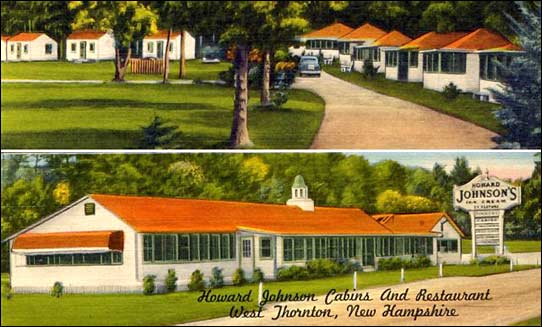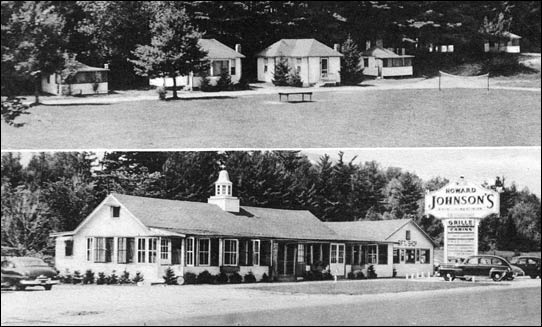West
Thornton, New Hampshire -- Rt 3 |
| |
The
following commentary is provided by Nate Coggeshall-Beyea who
has extensively studied and documented the history and development
of Howard Johnson's in New Hampshire:
The West Thornton
store was perhaps one of New Hampshire’s most unique and
shortest-lived HJ franchises. Located about 15 minutes north of
Plymouth, West Thornton was HJ’s northern most restaurant
along the Route 3 corridor. It was situated specifically to attract
motorists on their way north to Franconia Notch for skiing, sight-seeing,
hiking and camping, and a wide spectrum of other outdoor activities.
Franconia Notch was home to New Hampshire’s famed icon,
the Old Man of the Mountain, as well as countless other natural
wonders and beauties. The many mountains here offered commanding
views of the entire White Mountain range, drawing in visitors
from all over the world.
|
Skiing
was also a major attraction to the area, with Cannon Mountain
offering numerous trails for various levels of skill and expertise.
Its modern tramway from base to summit certainly made Cannon
Mountain a popular destination throughout the year, most especially
among leaf-peepers in the fall. Thus, Franconia Notch provided
a perfect backdrop for an HJ franchise.
|
| Postcard
ca. 1940s: Dan Donahue |
|
In an effort to preserve the natural magnificence of the Franconia
area, limited development was allowed inside the Notch itself.
As a result, towns just south of the Notch saw a tremendous
influx of business from motorists looking for a place to eat
or stay overnight before heading into the protected zone.
West Thornton was one such town, and it was soon dotted with
cabins, restaurants, and motor courts. The first known listing
for the West Thornton HJ store was 1947. It was designed as
a restaurant and cabin combination unit, most likely operating
previously under a different name and later converting to
an HJ franchise.
|
|
The restaurant was located
prominently on the immediate roadside of Route 3, with the cabins
set further back behind the restaurant. A small, heavily windowed
structure, the restaurant resembled a campground dining hall more
than an HJ. It was a one-story building with gable ends and a small
gable-end addition on the right-hand side. A smaller version of
a Mineola type cupola was perched on the roof-top, and an Bourne
type sign beckoned motorists passing by. The Orleans type sign has
proven to be a bit on an enigma. With West Thornton opening in the
mid-1940s, this sign type was definitely out of place, a throwback
to the mid-1930s.All roofs at West Thornton were orange, including
those of the cabins. A late 1940s or early 1950s addition to the
right-hand side expanded the restaurant’s capacity dramatically,
providing evidence that it was a booming enterprise at that time.
But success was short-lived at West Thornton, and by the early 1960s,
the store was no longer an HJ. Possibly a victim of bypass by Interstate
Highway 93, New Hampshire’s new central artery, this store’s
last known HJ listing was 1960. It lasted just over 13 years.
|
|
The
purpose of this site is informational. It is neither commercial
nor representative of any brand, company, or business. Trade names,
trademarks, etc. that are depicted remain the property of their
respective owners. Please contact this site's owner
prior to reproducing any part of it. Works from contributors (includes
photographs, ephemera, etc.) must not be reproduced without their
explicit consent. |
|


